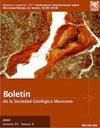Soil-archaeological studies of Koy-Gunzhar Scythian tumuli (Kazakhstan): building materials and techniques, diagenetic transformations of buried paleosols
IF 0.4
4区 地球科学
Q4 GEOLOGY
引用次数: 0
Abstract
The tumuli of the Koy-Gunzhar burial ground (2400-2000 cal years BP) in the North Kazakhstan are monumental earthen mounds, built in honour of the Scythian elite. The tumuli, besides representing the diversity of the building techniques for such earth burial mounds, also provide a unique opportunity to study the direction and character of the paleosol diagenesis for nearly 2400 years. This soil-archaeological study aimed to reveal mound building techniques, the characteristics of materials used for construction, and diagenetic changes of the buried paleosols. The comparative analysis of tumulus embankments and buried soils (their genesis and diagenetic transformations) provided the opportunity to establish the source of the building material and to reconstruct some details of the building technologies. For instance, the Calcic Someric Kastanozem (Arenic, Protosodic), buried by loam-sandy and sandy substrate of the tumulus 3, corresponds to dry steppe conditions and has no considerable signs of diagenetic transformations, whereas the paleosol under the tumulus 1 was affected by strong diagenetic transformation supposedly due to acid drainage from the embankment which originally contained sulfidic material being subjected to oxidation and acidification after the tumulus construction. Diagenesis was manifested in the redistribution of pedogenic carbonates and enrichment in iron, magnesium, manganese, and aluminum compounds in the upper 32 cm of the buried soil. These elements were partially accumulated at the carbonate geochemical barrier (over Bk horizon of the buried soil). This soil was transformed by diagenesis from Kasrtanozem to Mollic Cambic Umbrisol (Epiloamic, Katoarenic). The builders of the tumulus 1 used a loamier substrate to construct the mound, different from the parent material for adjacent soils (loamy sands and sands). The loamier substrate ensured the firmness of the mound construction. The builders employed an uncommon technique to produce a mound with defined properties and used foreign building materials brought from the distance.Koy Gunzhar Scythian tumuli(哈萨克斯坦)的土壤考古研究:建筑材料和技术,埋藏古土壤的成岩转变
北哈萨克斯坦Koy Gunzhar墓地(英国石油公司2400-2000年)的土丘是纪念斯基泰人精英而建造的纪念土丘。土丘不仅代表了这种土丘建造技术的多样性,还为研究近2400年来古土壤成岩作用的方向和特征提供了独特的机会。这项土壤考古研究旨在揭示土堆的建造技术、建造材料的特征以及埋藏古土壤的成岩变化。对土丘路堤和埋藏土壤的对比分析(它们的成因和成岩转变)为确定建筑材料的来源和重建建筑技术的一些细节提供了机会。例如,钙质Someric Kastanozem(Arenic,Protosodic),被tumulus 3的壤土-沙质和砂质基底掩埋,对应于干燥的草原条件,没有明显的成岩转变迹象,而tumulus 1下的古土壤受到强烈的成岩作用转变的影响,这可能是由于最初含有硫化物材料的路堤的酸性排水在tumulus建造后受到氧化和酸化的影响。成岩作用表现为成土碳酸盐的重新分布以及埋藏土壤上部32厘米中铁、镁、锰和铝化合物的富集。这些元素部分聚集在碳酸盐地球化学屏障(埋藏土壤的Bk层之上)。该土壤通过成岩作用从卡斯特黑钙土转变为软体寒武统伞形土(Epiloamic,Katoarenic)。土丘1的建造者使用了一种更肥沃的基质来建造土丘,不同于相邻土壤的母体材料(壤土和沙子)。松软的基质确保了土堆结构的牢固性。建筑商采用了一种不同寻常的技术来建造一个具有特定性质的土堆,并使用了从远处带来的外国建筑材料。
本文章由计算机程序翻译,如有差异,请以英文原文为准。
求助全文
约1分钟内获得全文
求助全文
来源期刊
CiteScore
1.40
自引率
12.50%
发文量
34
审稿时长
50 weeks
期刊介绍:
The Boletín de la Sociedad Geológica Mexicana is a completely free-access electronic journal published semi-annually that publishes papers and technical notes with its main objective to contribute to an understanding of the geology of Mexico, of its neighbor areas, and of geologically similar areas anywhere on Earth’s crust. Geology has no boundaries so we may publish papers on any area of knowledge that is interesting to our readers.
We also favor the publication of papers on relatively unfamiliar subjects and objectives in mainstream journals, e.g., papers devoted to new methodologies or their improvement, and areas of knowledge that in the past had relatively little attention paid them in Mexican journals, such as urban geology, water management, environmental geology, and ore deposits, among others. Mexico is a land of volcanos, earthquakes, vast resources in minerals and petroleum, and a shortage of water. Consequently, these topics should certainly be of major interest to our readers, our Society, and society in general. Furthermore, the Boletín has been published since 1904; that makes it one of the oldest scientific journals currently active in Mexico and, most notably, its entire contents, from the first issue on, are available online.

 求助内容:
求助内容: 应助结果提醒方式:
应助结果提醒方式:


